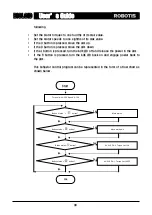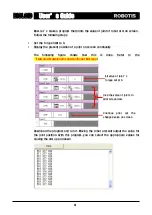
User’s Guide
there is one labeled Power. This will be ON when running on battery power and will
blink during recharging. When the recharging is almost finished, the blinking will
become faster. When the recharging is done, the blinking will become slow again.
Refer to the “3-2 Charging CM-5” or “Help Files\Charging CM-5. wmv ” video
clip.
Caution
Frequent recharging and draining of the battery will reduce the battery life quickly.
This is because of the memory effect and the recharging cycle limit of the battery.
The recommended number of times the battery should be recharged is 300. When
charging, do not disconnect the SMPS until the recharging is completely finished.
Disconnecting the SMPS and plugging it back again often will reduce battery life.
Also, do not charge the batteries without it being inside the CM-5 unit. A
temperature sensor inside the CM-5 measures the temperature of the battery
and determines whether the charging cycle is finished. If you charge the battery
outside the CM-5 unit, there is a danger of over-charging.
Low Battery Sign
The power LED will blink when the robot is low in battery power.
Let’s create a behavior control program that makes the robot arm do the
following.
Set the Dynamixel so that it can output 1/4 of its max torque.
Set the position of all the Dynamixels at their center position.
Torque Limit
Address number 34 of the AX-12 decides the torque limit. The max data value is
1023. In other words, if you load 1023 into address 34 of a AX-12 unit, then it will
move while outputting the maximum torque possible. If you want one fourths of
the max torque, then load 256, which is one fourths of 1023.
TIP
Only integers can be used when inputting numbers for the CM-5 unit. One fourths
of 1023 is 255.75 but you are not allowed to input this number thus the integer
number 256 should be used instead.
Why would one want to reduce the maximum torque limit? This is because you
could damage the robot if a joint moves to a position over its physically allowed
angle limit of a joint. To prevent this, test the robot with reduced torque first. If
you are sure that there is no problem with the movement, then you can increase
the torque back to normal.
Now let’s build a more complicated behavior control program that does the
38
Summary of Contents for Robotis
Page 1: ...Ver 1 00 BIOLOID User s Guide Closer to Real...
Page 55: ...User s Guide Portion that will be ignored Enable Disable Code Portions that will be ignored 55...
Page 73: ...User s Guide Move routine Stop Backward Left turn Right turn Melody sound routine 73...
Page 100: ...User s Guide Transmitter behavior control program Receiver behavior control program 100...






























